
Partial rotator cuff tears are a common cause of shoulder pain. It is not uncommon for most people to have an MRI report that mentions a partial rotator cuff tear. That tend to leads to a lot of fear, because most of you assume that a tear of any kind simply can’t be normal. For many of you a partial tear is a normal age appropriate change. It may or may not require treatment, and most do not require surgery. Skip down to the videos below if interested. Otherwise read on to learn more about this common shoulder condition.
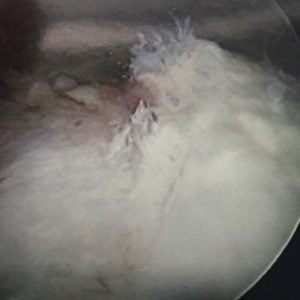
Partial rotator cuff tears are far more common than full rotator cuff tears. The term partial refers to how much of the thickness of the rotator cuff is involved. The rotator cuff tendons are a thick structure. If only a portion of it is frayed or injured then we call it a partial (see image to the right or below). These images of frayed tendons can be alarming, but these are common, and mostly normal changes that occur as we age. Not all partial tears are due to aging. Some are due to a sports injury too.
Common sports related rotator cuff pain can be caused by rotator cuff tendinosis, partial thickness rotator cuff tears, and full thickness tears. Although injuries do happen and account for a small percentage of partial rotator cuff tears, the majority of you do not recall injuring your shoulder. Remember, that is because your rotator cuff has simply started to degenerate or wear out. In pitchers or overhead athletes, these tears can occur due to overload of the tendons. That means that the tendons simply started to fail due to too much stress or too much activity.
As rotator cuff tendinosis progresses or worsens, the rotator cuff can develop a partial tear. Most people with partial cuff injuries do not require surgery, however, if surgery becomes necessary, new techniques allow us to potentially heal partial tears.
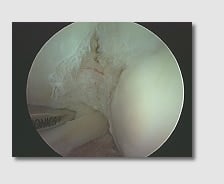
As Adam Rubin reported, Jonathan Niese, the NY Mets left-handed pitcher developed shoulder pain and was diagnosed with a partial thickness rotator cuff tear. Niese’s pain began during a game last week. This is a classic case with regards to the onset of pain in an overhead athlete. Eventually the rotator cuff can not stand the strain of pitching and it starts to fray or tear.
What is a Partial Rotator Cuff Tear:
We actually refer to these as partial “thickness” rotator cuff tears, as opposed to full thickness rotator cuff tears.
The rotator cuff are a series of four muscles which come together to cover the top of our arm bone in a “cuff” of tissue … which we refer to as the rotator cuff. In time, due to aging or repetitive stress – similar to the reason your favorite jeans have holes around the knees — the tendon tissue starts to wear thin and change its internal structure. This rotator cuff degeneration can progress, and eventually the rotator cuff tissue will start to lift off from its normal attachment to the bone and a partial rotator cuff tear is borne (see image- red arrow). Given more time, all the tendon tissue might separate in a localized area producing a full thickness rotator cuff tear.
Treatment of a Partial Rotator Cuff Tear
Many partial rotator cuff tears can now be healed with a biological patch which we place during a minimally invasive or arthroscopic procedure. Recent research shows these partial tears are capable of healing and regenerating.
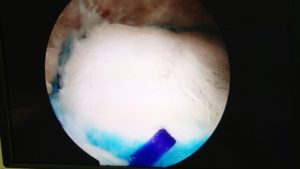
But many people with partial rotator cuff tears, even high level athletes will be nursed back to health with physical therapy. Certain people with partial rotator cuff tears have lost full internal rotation (the ability to reach up your back). That motion will need to be restored by your therapist if your goal is to fully recover. Some patients may choose to exercise on their own.. and products such as The Rotator might assist you if you have lost motion. In patients with persistent pain due to a partial rotator cuff tear, despite rest and therapy — an injection can be performed. Injection treatments for partial rotator cuff tears include cortisone, anti-inflammatories, as well as PRP and Stem Cells. The use of PRP and stem cells for the treatment of partial rotator cuff tears is controversial and very active research is underway in this area.
Here is video I recently did on whether or not partial rotator cuff tears can heal without surgery, and who may need to consider surgery.
Partial Tears and Bone Spurs
Many of you are told by your doctor that you have a partial tear of your shoulder because you have a bone spur. I can not stress strongly enough that this simply isn’t true. For many decades Orthopedic Surgeons felt that rotator cuff damage was caused by bone spurs. It was never proven to be true, but instead was adopted by surgeons worldwide. There has been a lot of research into this concept over the last 5-7 years. All of these studies show that the bone spur is not the cause of rotator cuff pathology, and removal of the bone spur has not been shown to be any more effective than a placebo. This video below goes into more detail about the concept of bone spurs and rotator cuff pain.
Surgery for partial rotator cuff tears
It bears repeating, the vast majority of you will not need to consider surgery for your partial tear. You will respond to physical therapy, injection or simply by waiting. There is no harm in waiting. Some research also shows that these tears can heal on their own. Some tears might progress or become larger over time. We can not predict who that will occur in. It does not happen quickly either.
Do you have questions regarding an Orthopedic injury or longevity?
Do you want to talk to an expert who can listen to you for 45-60 minutes and explain the options in detail?
Dr. Howard Luks offers remote guidance sessions to review your X-ray or MRI images and explain your options.
Dr. Luks has also received hundreds of requests for educational sessions on the topics discussed in his book, Longevity Simplified.
If non-surgical treatments of your partial rotator cuff tear does not enable you to return to your desired quality of life, then you can consider arthroscopic rotator cuff surgery for your partial tear. During surgery, which is performed arthroscopically, the partially torn area of the rotator cuff is smoothed out, and we can place a “bioinductive” patch over the degenerative or torn region.That patch might be able to heal a partial tear. It works in some, but doesn’t work in everyone. And surgery carries risks such as infection, stiffness, a reaction to the patch, blood clots, and so on. That gives further support to our message that surgery for these rotator cuff issues should be your last choice, and should only be considered if everything else fails to improve your pain.
Over time… that patch might begin to integrate into the rotator cuff possibly leading to healing of the tear. The patch could potentially reverse the degeneration or tendinosis of the rotator cuff which could prevent your pain from coming back again.
The vast majority of people with partial rotator cuff tears will improve with physical therapy alone and not require surgery.
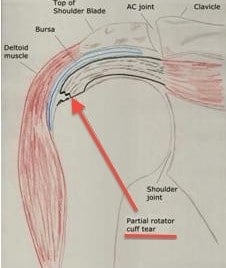

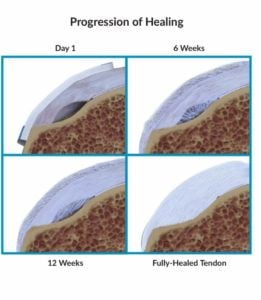

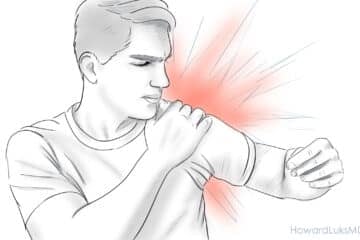

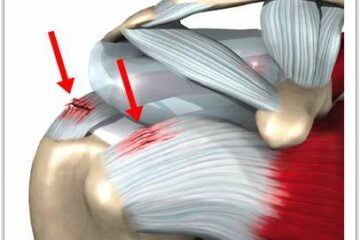








Simon day
Hi I have a large tear in the susprinatus tendon in my left shoulder. I fell over approx three months ago and have been suffering ever since. I struggle taking clothes off etc. My shoulder aches constantly and is especially worse on an evening. I have been unable to undertake physio due to the pain and have been taking oral morph. I would like to know if surgery would be the best route and how successful would it be after tearing the tendon over three months ago. Regards Simon day
Hard to say… I’m very leary about operating on people already on morphine before surgery. Consider a second opinion to review your options.
Ava Dawn
Hi Dr. Lucks,
Thank you for this post. I am a 24 year old with a partial rotator cuff tear. I’ve had symptoms since I was 15 years old and in the last two years it’s gotten worse. It is painful to move move my shoulder back, and if I do exercises that involve doing that, such as push ups, it feels as though something will snap out of place. I have neck and shoulder muscle spasms very often. The muscle spasms make it difficult to breathe and sleep at night. This happens every couple of days.
I’ve tried physical therapy, chiropractic, OMM, rest..etc. They all seem to help for a few hours but the spasms return. I’m applying to medical schools and don’t want to carry this with me through med school and residency. You mentioned that if all else fails, surgery would be the last option. I’ve tried all my options for the past 5 years. When is a good time to consider surgery? I saw an orthopedic surgeon who said he simply won’t do surgery on partial tears and to continue doing what I’m doing. Is this view generally acceptable by all physicians? And how can I find a physician who is honest in his advice but open to work with me if I elected to have surgery?
Thank you
I hope you find a shoulder physician who can assist you. keep searching.
Tim
Dr. Luks,
I received a prp injection 2 weeks ago on my rotator cuff which has a 1.5cm tear in it. From what i was told a 2 to 4 cm is considered full thickness tear. Have you seen prp heals partial tears at least to any degree? Would trying a second prp if the ultrsound shows some tissue repair be worthwhile down the road? Any input would be greatly appreciated! Thanks in advance, you have a great column here.Tim
Hmm .. You can have a 5 mm full thickness tear or a 5+ cm full thickness tear. The size of the tear doesn’t define if it is full thickness or not. The depth of the tear does. So you can have a 2 cm long partial tear or a 2 cm full thickness tear. PRP will not heal partial tears, but it can help diminish the inflammation and pain.
Laura S
Thank you! I guess I’m going the right direction then. Waiting for therapy appt. I’m also going to request a Specialist Appt. for a second opinion (or first, in this case, since a Dr hasn’t explained them to me yet).
Laura S
This is what my mri showed. A physiologic amount of fluid present within the joint. This limits detailed evaluation of the labrum. No focal labral tear is seen from 3-12 oçlock or secodary signes of tear such as paralabral cyst.
IMPRESSION: 1. Low to moderate grade, partial tear of the supraspinatus tendon. There is no evidence of high-grade partial or full-thickness tear. 2. Tendinosis of the biceps tendon as described in detail above. There is no evidence of biceps tendon tear. 3. Moderate Degenerative changes to the left acromioclaviular joint.
I’m in extreme pain. I can’t do normal things during the day. wash my hair, reach to wash my legs, dress myself, etc. I can’t sleep at night for the paid in 10x worse at night. I finally went to get my results from the records dept. These haven’t been explained to me. All I’ve gotten is a letter to take to make a physical therapy apt. Not sure what I have, or if there’s hope at the end of this ordeal.
Seems like the rotator cuff might be the cause of your pain … While injections and therapy are typically very useful it would be nice if your doc would take the time to explain that to you. Perhaps you want to consider another opinion to decide on a treatment plan that is most appropriate for you.
Mark
This latest study has me concerned that PRP may have made my RCT worse now:
http://www.ncbi.nlm.nih.gov/pubmed/26498958
Thoughts?
Mark
Thanks for getting back, Dr. Lutz.
The post-injection pain has been insurmountable, particularly since the third and last injection. It has left me unable to do any exercise at all right now, but it is only the third day post. I am waiting to hear if the injection(s) were done in the subacromial bursa.
I just hope the treatment didn’t damage my tendon further because it sure feels like it. I had impingement in my opposite shoulder a couple years ago in which PT and time healed it and I have no further pain. But that is different from a tear.
My whole idea was to obviously avoid surgical intervention. According to my doc and what I’ve read, there is a 70-80% chance PRP + the GH will help. But had I known the pain was going to be this intense and debilitating, I would’ve probably opted not to do PRP and wonder if just PT and rest like I did before would’ve been a better option, but that’s water under the bridge now.
I guess I will just have to wait it out for now?
Mark
55, male, avid lifter, 4-5x’s/week in the gym. Have right partial supraspinatus tear. Started PRP mixed with rhGH (4iu Omnitrope) earlier this month. Completed my last injection today [1st was injection into the tendon; 2nd into the joint; 3rd, tendon (larger volume of PRP injected in two regions)]. Inflammation was pronounced immediately following the initial injection and has not subsided since. Last injection (today) produced the most acute inflammatory response in which non-NSAID pain meds (Tramadol + acetaminophen) were necessary. I have also been using ice throughout (even before the injections).
I understand that the duration and intensity of the inflammatory response phase varies widely per patient, and is a necessary component of the healing process as my physician explained, but I have never experienced chronic pain before and ws starting to get a bit concerned as it is much worse than before the injections.
MRI report as of May, 2015:
https://app.box.com/s/9usckm6ei4m0d8xi53neunh8075ly5b8
Ultrasound images as of today:
https://app.box.com/s/c1b6tiy5six85ad8essnnv1pa4lwpstr
https://app.box.com/s/5dernarxpux5f08gk9syaqpzv25xp7pa
Based on my data, what would be an estimate of time I can expect the inflammation to subside, and though I realize no one can guarantee a positive outcome, what would you say the likelihood of recovery of a partial RTC tear is percentage-wise?
Due to the pain with any overhead movement, I am basically out of commission to do any upper body resistance training (other than super light and nothing directly involving the shoulders).
Anything else non-drug you can recommend to speed recovery and reduce inflammation?
Also, are you familiar with Regenexx-SCP which is supposedly a superior form of PRP therapy? http://www.regenexx.com/regenexx-scp-platelet-rich-plasma-prp/
The cost is also at least twice the cost of “conventional” PRP injection therapy. Would like to get your thoughts on it.
Much appreciated for taking the time to respond.
Hi Mark…
At best there is limited data to support PRP healing partial rotator cuff tears. The inflammation from the injection can last for a few days. In my experience rarely for more than a week. Unless the subacromial bursa was injected then the inflammation there, as well as your AC Joint might persist and continue to be an issue. I am familiar with Regenexx. Sadly they do not perform true, blinded control studies so there is no way to know if it actually superior to anything else we do.
Tendinosis and partial cuff tears hurt… often a lot. Recent studies have confirmed what I have said for years — the amount of pain you have has no correlation to rotator cuff tear size, etc. Often these partial tears can hurt worse than full tears.
Without examining you and knowing what the likely source of pain is I can not comment further. If you do ever need to consider surgical intervention, the rotation medical patch might be something to review with your surgeon.
Good Luck
Howard Luks
Jeff
Thanks Doc for getting back so quickly!
Jeff
I am a military veteran and have a appointment next week to see a orthopedic Doctor at the VA. I have to say that I’m not very good with all this doctor lingo regarding my MRI results. Was maybe hoping you can give me some insight as to what it means and what can be done, the following are my results of the MRI done at the VA.
Longitudinal split of the proximal long head of the biceps tendon with mild tenosynovitis.
Significant partial thickness undersurface tearing of the distal supraspinatus tendon.
Small focus of partial-thickness undersurface tearing at the insertion of the superior fibers of the subcutaneous soft tissues of the posterior right shoulder.
Any help would be greatly appreciated.
So your exam would matter significantly. But the biceps tendon near the shoulder is intimately related to the rotator cuff tendons. They are right next to one another. Both your rotator cuff and your biceps are degenerating. At least that’s what the MRI says. Not serious OMG damage, but the process is starting. Physical Therapy, perhaps an injection etc are likely starting points for treatment.
Good Luck
Matthew Houstoun
I had an MRI done which found a partial tear of the Subscapularis tendon,mild posterior humeral head subluxation and tendinosis of the supraspinatus and infraspinatus.
I have good range of motion and no serious pain.I’ve had PT and still experiencing soreness and burning going from neck down to hand.Now Im having sharp pain on bicep when putting arm back over shoulder.
Dr thinks it may be time to scope the shoulder.
tread lightly … pain radiating from your neck to your hand is not because of the shoulder. usually due to the neck. have your doc check it out
arya saffaiea
thank you for that, do you belive it is possible to not further tear even if i lift heavy weights 4 times per week? assuming i do not use the rotation therapy. healing would be great but at the moment I’m more worried of further tearing while lifting weights.
Rotator cuff tendinosis and partial tears can progress … albeit very slowly. They will progress if you lift weights or if you don’t. Given all the new science on newer techniques to work out — funcitonal — there is no reason to lift heavy unless you are competing .
arya saffaie
Good afternoon Dr., I am a professional bodybuilder I have recently had gone under subacromial decompression surgery in my shoulders. I have a type to a chromium as well as a bone spur they removed that was creating impingement and damaging my rotator cuff, upon an MRI before the surgery it was notated that I had a small grade to articular sided partial rotator cuff tear, I trust my Dr. however im just seeking a second opinion in regards to the rotator cuff tear. It was not big enough to need repair when the doctor saw it orthoscopicly he mentioned from the outside the looked just a little banged up as that is normal because I am am a bodybuilder.
So my question is, now that the bone spurs removed which was the primary reason for pain that eventually led to the partial tear that I have if I continue to lift weights heavily is that almost certain that it will progress to a full tear or is that not necessarily the case? I do a lot of strengthening exercises and a lot of r rehab and I still have a lot of strength without pain however I feel insecure that I may be little by little tearing my tendant further. Is there some cases where I could still use my shoulder in a bodybuilding manner but not increase a partial tear to a full tear? Thank you for your time
This is a post that might be of interest to you. Partial tears can progress over time… not all of them, but many.
https://www.howardluksmd.com/orthopedic-social-media/rotator-cuff-tendinosis-is-a-cure-possible/
Howard Luks
Elaine
Hello Dr Luks. I have been suffering from severe pain in left shoulder for 3 yrs now. Had an MRI done that showed bone spurs, arthritis, inpingement, and an interstitial supraspinatus tear (greater than 50%). Had surgery but surgeon didn’t fix the tear as he did not see it. I was in much more pain after the surgery, and asked for an MRA. It showed a “probable” tear (greater than 50%), and severe tendonitis. I cannot sleep, am in pain 24/7, and cannot lift more than a pound. My arm also shakes when I try to lift it. I am much worse than before my surgery. Does this sound like a tear to you??
You might find this post to be very helpful.
https://www.howardluksmd.com/orthopedic-social-media/rotator-cuff-tendinosis-is-a-cure-possible/
Gloria
Dr. Luks, I had a injury a week ago that caused my arm to be pulled up very abruptly. After much pain I had an MRI 4 days later. The MRI showed a full-thickness slightly retracted tear of the anterior middle third fibers of the distal supraspinatus tendon with the fibers retracted approximately 7mm at the distal supraspinatus footprint. There is also a 5mm tear in the anteroposterior dimension from sagittial plan view. And just posterior to the area of full-thickness tearing is a moderate grade partial thickness tearing in the posterior fibers of the distal suprapinatus tendon. When there is retraction does it mean it was probably an old tear? Thank you so much for your response
It’s often hard to tell …
Bob Zaita
I have been recently diagnosed with a partial-thickness (75%) insertional , intrasubstance tear of the supraspinatus footprint insertion, which involves the anterior aspect of the tendon. I am investigating the appropriateness of the Rotation Medical product for my case. Have you done any cases using it? If yes, have you been satisfied with the outcome(s) and do you think it might be appropriate for my diagnosis? Thank you very much. Bob
Hi Bob … i have been using this implant for a while… so far we are very happy with our results.
Most patients with partial tears will respond well to therapy, etc and not require surgery. If, however, surgery does become an option due to failure of non-surgical management then the implant does become an option.
Tyise
I injured my right shoulder sept 2013 I was told I had partial tears in November and by January 1st I was told they had healed but I had bursitis and tendinitis which wasn’t on my original MRI I am going on 2 years post incident and all I can say is I am in pain 80% of my days my shoulder only goes about 130 degrees upward my internal rotation is poor and extremely painful i also have pain throughout my right arm and hand which I was told was from a slight bulging disc cervical spine I have done PT injection and medicine nothing has relived my pain not even a little I progressively feel worst with no explanation is it possible that my tear did not go away or could this be something else
Stiffness after an injury can lead to continued pain. Tears are not the only reason why our shoulders hurt. Most people with shoulder pain do not have full tears, or partial tears. They have inflammation and limited motion. IF PT, injections, etc have not led to any relief then you need to possibly speak with another shoulder specialist about your condition and what options are available.
Harry
Dr. Luks
My name is Harry, I am a 13 year career firefighter I injured my left shoulder at work bench pressing 175 pounds. This happened 01/07/2015 I continued working until 1/25/2015 at which time the pain and range if motion caused me to go off the truck. I went to the doctor with a shoulder sprain and began therapy 2x a week for 3 weeks. After my 6th therapy session (no change possibly worse than before I started therapy) I reported back to the doctor and an MRI was ordered. Found was a Articular-sided partial thickness tear of the distal supraspinatus tendon. More diffuse fibrillation along the bursal surface of the supraspinatus. No full-thickness rotator cuff tear. Very minor marrow contusion along the lateral humeral head at the greater tuberosity. No fracture. The tear extends through 50% of the tendon thickness. I was ordered to continue therapy 2x a week for 4 more weeks no change in the pain and mild change in the range of motion. Not sure what the next step will be, I have been told by my doctor that its possible that my partial tear has become a full thickness tear, or frozen shoulder has started. The only way to know for sure is to scope it….your thoughts please and thank you!!!
YIKES .. Partial tears can certainly hurt. Most people with shoulder pain do not have a full tear. Partial tears can hurt just as much. A frozen shoulder simply means that the shoulder does not move as much as your other shoulder does .. it is a very easy diagnosis to make. We are able to repair partial tears if therapy has been unsuccessful in alleviating your pain. But these are not easy repairs so be sure to see a true shoulder specialist with a lot of experience fixing partial tears.
Nico
Hi Doctor Luks,
I’ m 35 years old and very active (I did Crossfit for some years) Last year I had a surgery to my right shoulder to repair a small full thikness tear in my supraspinatus associated with tenodesis. The rehabilitation was very though and painful developing a light capsulitis and having lots of biceps spams. Now my right shoulder is quite ok….but unfortunately MRI on my left shoulder said that I have a type II acromion and an “initial fibrillation of the supraspinatus tendon fibers” due to a partial tear of type A1 according Synder classification.
At the moment, I occasionally have only a slight discomfort (no pain with any sort of movements) near the biceps groove, but I fear that keeping on training even if avoiding any havy and “dangerous”lift especially overhead it progressively getting worse in time. Just would like your opinion about this A1 partial tear. Sorry for the long post. Many Thanks, Nico
Partial tears can worsen over time. That’s why we are very excited about the potential of the Rotation Medical Bioinductive implant … we have been using them for a while now. The research seems to show that it reverses the degenerative process and heals the partial tears before they can progress to full tears.
Dr.A.K.Venkatachalam
Dr.Luks
I am a 54 year old Orthopedic surgeon in India. I have got 50% 4 mm wide bursal side partial thickness rotator cuff tear. As I am in practice, I can’t afford to take time off for rehab after a repair. Is there a PRP option available?
It is an option … but there is not a lot of literature to support it. One technology that might eventually interest you is the Rotation Medical Rotator Cuff implant which has been shown to heal these partial tears and reverse tendinopathy.
Gina
Hi doctor
I have partial tear in my shoulder pain improving and will start exercise prescribed by my primary.,, she said j don’t have go see orthopedist. Don’t know how I did this. My question is I’m a swimmer…could this have caused it? She says if will heal but would swimming cause further damage or injury? I am very confused
You will never quite know what caused it. Genetics, activity, etc all have a role in causing degeneration and fraying (or tearing). Some of these tears will become larger, some may not. If your pain improves with PT then you are ok to continue swimming. Staying active in life is important for many reasons… and swimming will likely only play a small role in whether or not your partial tear will become larger.
Jason
Sir,
I have a partial thickness tear in my left (non-dominant) supraspinatus confirmed on MRI as a result of a fall three weeks ago. Being a active 41 year old I am on the fence about surgery versus PT. My surgeon is recommending arthroscopic viewing and expecting to have to put one anchor based on physical eval and that this was an acute injury with no history of pain, the physical therapist seems to agree yet both insist that this is “my call”. I have virtually full ROM with some weakness and pain at the spot of the tear with certain movements. With the recovery being 3-6 months or more for surgery I’m wondering if trying PT for a timeframe first would be best?
There’s no rush for a partial tear. They are very common and your pain may respond to physical therapy alone.
michele
I have a partial tear of the rotator cuff diagnosed Monday by ultrasound. I felt it when it happened and I can not return to work until I have full use of my arm again. My doc had no real answer for me when I asked how long it might take. Would you be able to offer me any insight on how long I might be out?
Sorry… I can not offer any insight without examining you.
judith
Dr. I saw an orthopedic specialist today. I have to get an MRI this week & see him on Monday. His orders wrote complete tear of rotator cuff, primary o cannot it going what Primary means. I also have stenosis of the cervical spine. I am getting traction and using tens. I also am using tens for a very bad fall last July and have both needs total replacement. If you could tell.me what Primary” means. I didn’t read these orders until I got home from the exam. Thankyou
means he thinks the cuff tear is the source of your pain… or at least I think that’s what he means… better to ask his staff :-)
Jan Schmalenberg
I have had problems with my right shoulder and have had a number of tests at Virginia Mason Hospital in Seattle. X-rays, MRI, EMG, reviews and etc.. It seems I have some small bones spurs and a partially torn rotator cuff in the shoulder. The shoulder surgeon wants to set up an operation (I am doing the C-8 through-the-rear-back-surgery cervical first that is effecting my left arm….nerve root impingement) but I am hesitant to have the recommended surgery on the right arm. I am researching what can be done to eliminate the spurs naturally and also Stem Cell injection for the torn muscle. Can you help with my decisions?
Hi Jan … The shoulder community accepted long ago that the spurs are not the source or cause of rotator cuff related issues. Folks with partial tears, and a secondary bursitis will generally respond to a well executed therapy program concentrating on the rotator cuff and muscles around your scapula.
Good Luck
Howard Luks
Tina
Hi Doctor Luks,
I have been suffering from rotator cuff pain in my left shoulder for 13 months now. I’m 27 years old and I’m pretty sure it was from my handstand (yoga) practice. My PTs originally diagnosed it as bursitis, since I had severe pain for about a month (including when sleeping). Since March of 2014, I’ve been in this cycle of being virtually pain-free to developing light to pretty moderate pain, even though I’ve been doing PT for a whole year (scapular stabilization, stretching, RC strengthening). I haven’t done handstands in a long time, no yoga, or any overhead work for that matter. However, I am very active (avid skier, mountain biker, environmental field work, yoga teacher). When I start to try developing strength by doing planks and modified push-ups (when I’m pain free), I usually flare up, and the pain lasts about 10-14 days. Even doing light field work involving carrying things that aren’t too heavy will flare up pain. I’m sure skiing and mountain biking don’t help the healing process. This has been mentally very debilitating- I want to enjoy yoga, handstands, and be strong and 100% again. I’m so sick of waking up every morning and wondering if I’m going to have pain. I have a feeling I have a partial tear.. Any thoughts? I think my next step is an MRI.. I need answers.
Thank yo so much!
Tina
Tina .. kudos for your efforts. You have done everything properly. It’s often wrong to run straight to an MRI when a joint hurts, but now it seems like that might be the right place to go. I would start with a solid exam by a good shoulder doc and take it from there.
Good Luck !
Dan
I am 57 and a carpenter. 5 weeks ago as I was pulling with one hand and pushing with the other when i felt something tear in my r shoulder. Acute pain and weakness followed. I worked one more week babying the shoulder and have rested it for the last 4 weeks. It is still very tender at times but I can move it ok. Late at night for no reason it throbs painfully. My bicep, neck and back of shoulder are very sore most of the time. I’m assuming a sight tear. WIll it heal by itself? At what point should I see a Dr. ?
HI Dan… this is a very common scenario. Weakness which is due to pain is understandable… but true weakness should be evaluated sooner rather than later.
Good Luck to you.
Howard Luks
Dean
Hi Dr Luks so thankful I found your website. Three months ago I irritated my left shoulder while military pressing. After a couple months I went to a art therapist who is also a chiropractor, he ordered an MRI and it says I have some tendenosis of the supraspinatus and a 3 mm partial tear of the subscapularis. Everything else including the bicep was normal. It really doesn’t cause any pain just mild discomfort occasionally, I lead a very active lifestyle and really want to avoid surgery if possible. My biggest concern is it progressively getting worse in time. I stopped bench pressing years ago and now will give up overhead work but I still love to work out even if I have to substitute some machines. Just would like your opinion sorry for the long post. Thanks, Dean
Thank you Dean!
A 3 mm partial “tear” is virtually normal. I wouldn’t worry about it. Enjoy your active lifestyle :-)
Linda
I am 59 years old and have a 2 cm supraspinadus tear and a labrum tear. Some doctors recommend surgery some physical therapy. I have had 2 months of therapy and it has helped tremendously but I still have pain at night and something pulling clothes off over my head.
I am not sure if I want the surgery. What do you think?
HI Linda..
Many papers .. including this one – http://jbjs.org/content/96/22/1922 show that PT is the proper method of treating atraumatic, degenerative rotator cuff tears. The American Academy of Orthopedic Surgeons recommends physical therapy as well as the primary treatment for atraumatic degenerative rotator cuff tears. You are the primary decision maker now… if your tear is stable (not getting larger) and your symptoms are tolerable then you may not want to have the surgery. Without evidence that your tear is getting larger, this is primarily a quality of life decision for you.
Good Luck
Howard Luks
Dustin
Hello Dr. Luks I fell 4 to 5 months ago on my elbow and it made my shoulder go up. When I fell there wasn’t any bad pain or anything and it was just sore for a few days afterwards. When I would try to bench press even with 135 pounds I could feel a little pain in between my shoulder and chest and my max was 280. I went to my orthopedic surgeon for a knee appointment and asked him about it and he said he thought I had probably sprained my pectoral maximus tendon and to give it 6 weeks. So I quit lifting all the way up until two weeks ago because I could tell it still wasn’t right. So I went to the gym and lifted with no pain however it was sore afterwards and felt looser. It snaps and pops regularly and if I lay on my back with my arm in the air and turn it I can hear it grate. I have no problem with every day things for the most part and it normally doesn’t hurt unless it gets caught at a weird angle or is used a lot. I’m wondering if you may know what is wrong with and if lifting weights will damage it further?
Sorry Dustin… Without examining you it’s hard to say. If you’re concerned perhaps another visit to a shoulder doc would be worth your time. It doesn’t sound like a pec major strain.
Good Luck.
Gabriel Anton Stephin
Thank you… Sir
Gabriel Anton Stephin
Thank you… Sir
Gabriel Anton Stephin
Sir for about a 11months i am suffering from shoulder pain of right side.. So i went under for radiology investigation the MRI report of mine showed Subscapularis tare with bicepital subluxation into the tear… And the tare is mentioned in the report as substance partial tare of 14mm where the bicepital tendon is sublucted and placed into the tare… The problem is everynight i sleep i sufer pain… And my right shoulder seems to be down comparing the left shoulder… I am a student of 3rd year Physiotherapy… Even i had undergone for unltrasound for 3 months… Took NSAID drug also.. Still the pain continues.. Is it necessary for me to go for surgery…
Sorry Gabriel… Subscap tears with biceps sublimation is a very unique tear. Many people do not do well with therapy for this combination. Time to talk with your surgeon about the options available to you.
Howard Luks
Christophe
Hi,
In case one has a partial rotator cuf tear (more specific the supraspinatus), will the tendon itself actually heal on its own? I mean I can imagine someone with a partial supraspiantus tear stops complaining about symptoms after a while because he/she got better but that doesn’t mean necessarily that the tendon itself healed.
So my question is whether the supraspinatus partially torn tendon can heal on its own?
(I lift eights, hence it seems important that the tendon actually heals properly).
There are occasional papers in the literature that show that some tears (rarely) can heal themselves. Most partial tears are simply the natural progression of rotator cuff degeneration, or tendinosis. That’s where the rotator cuff starts to degenerate internally, then it starts to fray, then it starts to lift off the bone. Keep an eye on a new product from Rotation Medical… the patch they have has been shown to heal partial thickness tears and reverse tendinosis — but more researches needed.